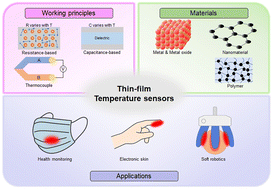With the advancement of the Internet of Things (IoT) and wearable electronics, the demand for flexible and highly sensitive thin-film temperature sensors has been increasing. Conventional rigid sensors face limitations in environments requiring conformability and stretchability, leading to active research on thin-film temperature sensors using various materials and fabrication techniques. Metals, metal oxides, polymers, carbon-based materials, and 2D materials have been explored as key candidates for enhancing thermal sensitivity, mechanical flexibility, and long-term stability. Additionally, fabrication approaches such as laser patterning, inkjet printing, and sputtering have improved precision and scalability in sensor production. However, challenges remain in ensuring long-term durability, environmental stability, and seamless integration with emerging technologies. This review highlights recent advancements in thin-film temperature sensors, focusing on external strategies for performance enhancement and practical applications. Furthermore, it discusses key technological challenges and future research directions essential for the continued development of thin-film temperature sensors.
